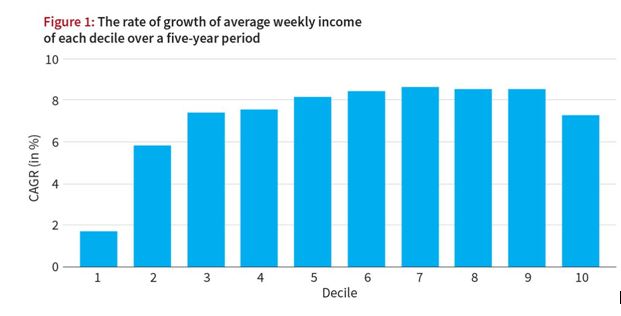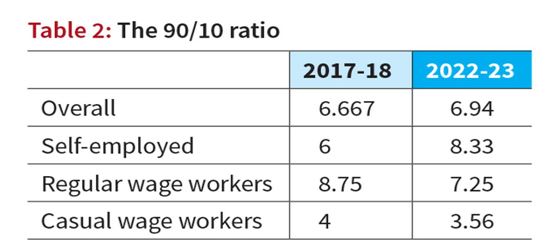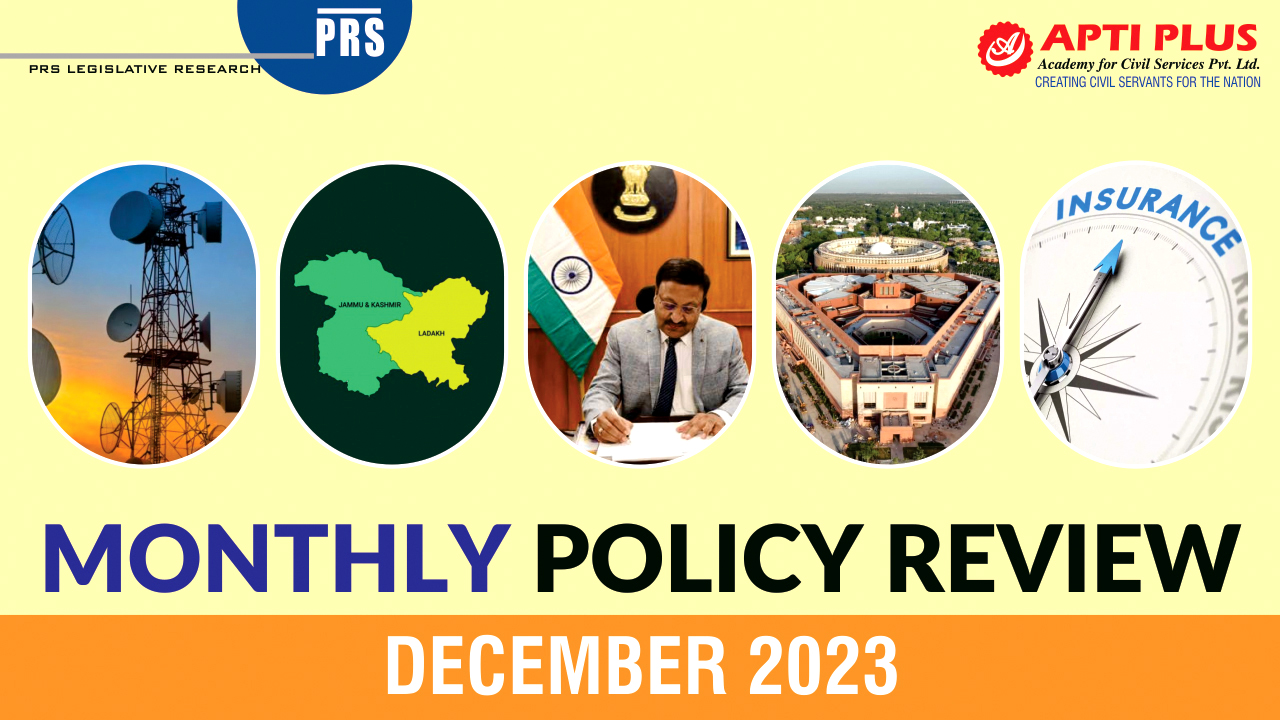
Copyright infringement not intended
Picture Courtesy: thehill.com
Context: The State Bank of India (SBI) recently reported a significant decrease in income inequality in India over the past decade, as indicated by a fall in the Gini coefficient from 0.472 in 2014-15 to 0.402 in 2022-23.
Key Highlights
- The State Bank of India (SBI) report indicates a significant decrease in inequality in India over the last decade, citing a fall in the Gini coefficient from 0.472 in 2014-15 to 0.402 in 2022-23. However, reliance on taxpayer data raises concerns as the majority of income earners fall outside the tax net.
- This analysis relies on taxpayer data, leading to some limitations as a majority of income earners fall outside the tax net. The 2022-23 Periodic Labour Force Survey (PLFS) data reveals that nearly 80% of income-earners earn less than ₹2.5 lakh per annum, the minimum taxable amount.
PLFS Analysis and Nature of Employment
- Using PLFS data from 2017-18 and 2022-23, the analysis categorizes income earners into self-employed, regular wage, and casual wage workers. Despite a general reduction in inequality, the study reveals nuances in the changes.
Preliminary PLFS Analysis
- The PLFS records the gross incomes of the self-employed, providing a more in-depth analysis. The preliminary analysis considers nominal weekly incomes, excluding unpaid family helpers, and does not adjust for potential errors in self-reporting or seasonal adjustments.
Gini Coefficient Trends
- The Gini coefficient declines from 0.4297 in 2017-18 to 0.4197 in 2022-23. However, when comparing different forms of employment, it falls for regular and casual wage workers but rises for the self-employed, though changes are minimal.
- The Gini for self-employed workers increases by 1.5%, while for wage workers, it decreases by 1.7% and 4.8% for regular and casual wage workers, respectively.
Polarization in Incomes
- Despite an overall reduction in the Gini coefficient, the analysis uncovers a polarization in incomes. Incomes of the top 10% grow faster than the bottom 30%, particularly among self-employed workers.
Income Polarization Process
- The data outlines a polarization process in the Indian economy. Deciles are used to divide income earners, showing a divergence in fortunes between the top 10% and the bottom 30%. The top decile experiences faster income growth, while the bottom decile sees the slowest growth.

90/10 Ratio Changes
- The 90/10 ratio, measuring the income gap between the top 10% and bottom 10%, increases from 6.7 in 2017-18 to 6.9 in 2022-23. Changes in polarization are evident among different forms of work.

Polarization among Different Employment Types
- Changes in polarization are examined among self-employed, regular-wage workers, and casual-wage workers. The 90/10 ratio decreases for wage earners, especially regular wage workers, but significantly increases for the self-employed. In 2022-23, the income of the top 10% of self-employed individuals is 8.3 times that of the bottom 10%.
Rising Gaps in Income
- Income inequality is a serious issue that affects the economic and social development of a country. It refers to the uneven distribution of income among different groups of people, such as the rich and the poor, the urban and the rural, the formal and the informal sectors, etc.
- Income inequality can have negative impacts on various aspects of human well-being, such as health, education, social cohesion, political stability, and environmental sustainability.
|
Income inequality in India
●According to the World Inequality Database, the share of income going to the top 10% of earners increased from 30.5% in 1980 to 56.1% in 2019, while the share of income going to the bottom 50% of earners decreased from 24.7% to 14.7% in the same period. This means that the richest 10% of Indians now earn more than four times as much as the poorest 50%.
●India's income inequality is higher than that of many other developing countries, such as China, Brazil, Indonesia, and South Africa.
|
Factors contributing rising gap in income
- The unequal access to quality education and skill development opportunities for different segments of the population, especially for women, minorities, and rural dwellers.
- The unequal access to productive assets and resources, such as land, credit, technology, and infrastructure, for different sectors of the economy, especially for the informal and agricultural sectors.
- The unequal access to social protection and public services, such as health care, sanitation, water supply, and social security, for different groups of people, especially the poor and vulnerable.
- The unequal participation in political and institutional processes, such as decision-making, governance, and accountability, for different sections of society, especially for the marginalized and excluded.
Steps taken to reduce income inequality and promote inclusive growth
- The Mahatma Gandhi National Rural Employment Guarantee Act (MGNREGA) provides guaranteed employment and income support to rural households.
- The National Food Security Act (NFSA) provides subsidized food grains to eligible beneficiaries.
- The Pradhan Mantri Jan Dhan Yojana (PMJDY) provides universal access to banking services and financial inclusion.
- The Pradhan Mantri Ujjwala Yojana (PMUY) provides free cooking gas connections to poor households.
- The Pradhan Mantri Awas Yojana (PMAY) provides affordable housing to the urban and rural poor.
- The Pradhan Mantri Kisan Samman Nidhi (PM-KISAN) provides direct income support to small and marginal farmers.
- The Ayushman Bharat Pradhan Mantri Jan Arogya Yojana (AB-PMJAY) provides health insurance coverage to low-income families.
Challenges
- The lack of adequate funding and resources for these schemes resulted in low coverage and quality of service delivery.
- The lack of coordination and convergence among different ministries and departments involved in these schemes resulted in duplication and fragmentation of efforts.
- The lack of transparency and accountability in these schemes resulted in leakages and corruption.
- The lack of awareness and empowerment among the beneficiaries of these schemes resulted in low uptake and utilization.
Way forward to achieve more equitable and inclusive growth
- Investing more in human capital development, especially in education and health care, for all sections of society.
- Promoting more inclusive and diversified economic opportunities, especially in the formal and non-farm sectors, for all segments of the population.
- Strengthening more progressive and redistributive fiscal policies, especially in taxation and public expenditure, for all levels of government.
- Enhancing more participatory and responsive governance systems, especially in decentralization and social audit, for all stakeholders.

Conclusion
- Rising gaps in income is a complex and multidimensional problem that requires a holistic and integrated approach from all actors. India has made some progress in addressing this issue but still has a long way to go. By adopting more effective and inclusive policies and programs, India can achieve its vision of a more equitable and prosperous society for all its citizens.
Must Read Articles:
INDIA’S GROWTH TRAJECTORY: https://www.iasgyan.in/daily-current-affairs/indias-growth-trajectory#:~:text=Income%20inequality%20in%20India%20is,a%20rural%2Durban%20income%20divide.
6th PERIODIC LABOUR FORCE SURVEY (PLFS) DATA: https://www.iasgyan.in/daily-current-affairs/6th-periodic-labour-force-survey-plfs-data#:~:text=The%20Periodic%20Labour%20Force%20Survey%20(PLFS)%20is%20a%20quarterly%20survey,in%20rural%20and%20urban%20areas.
|
PRACTICE QUESTION
Q. Can technological advancements contribute to both rising income inequality and its solution? How can India harness automation and technological innovation to create and distribute wealth more equitably, rather than exacerbating existing disparities?
|



